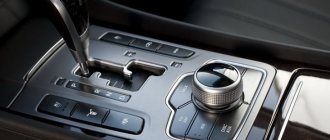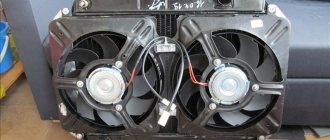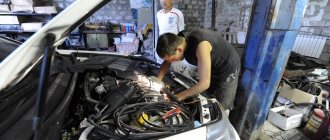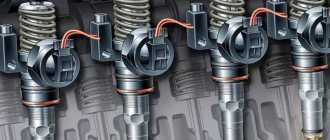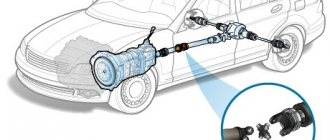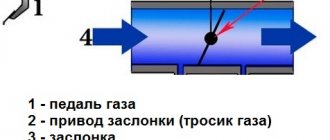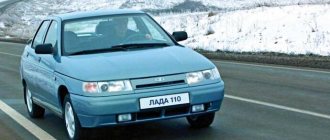Automatic transmission overdrive mode: what is it, purpose, principle of operation
Given the great popularity of hydromechanical automatic transmissions, manufacturers manufacture this type of transmission in such a way as to achieve maximum user convenience and versatility. At the same time, there is also the task of reducing fuel consumption.
As you know, the most common today is a simple four-speed automatic. As a rule, these gearboxes have several standard and understandable operating modes, which greatly simplifies operation.
However, on many automatic transmissions, in addition to the basic ones, you can also find additional modes. In this article we will talk about what overdrive is on an automatic transmission, how overdrive on an automatic transmission is turned on and off, why this mode is needed and when it is used.
Overdrive mode and fuel consumption
During our introduction to the operating principle of Overdrive, we stated that its use saves fuel. As practice shows, this effect is rather demonstrative in nature, indicating that less fuel is actually consumed.
That is, the driver, with proper use of the mode, which involves turning it on/off in a timely manner, can save a little, but you should not count on a significant reduction. So any myths about the influence of Overdrive on fuel consumption should be taken with a considerable amount of skepticism. There are savings, but they are insignificant.
Why do you need overdrive on an automatic transmission?
If we consider the design of an automatic transmission with 4 gears (steps, speeds), in this case the 3rd gear is direct, that is, it has a gear ratio of 1, which is similar to the 4th gear of a manual transmission.
In this case, 4th gear in an automatic transmission is also called overdrive or O/D. By analogy with mechanics, the gear ratio of this gear is less than 1, that is, an overdrive gear, like 5th gear in a manual transmission.
The overdrive button can be located on the automatic transmission selector or placed separately. So, if automatic transmission overdrive is turned on, this means that the automatic transmission will switch to 4th (higher) gear at high speeds, and also if the driver lightly presses the gas pedal. After engaging 4th gear, the torque converter lockup is activated.
In practice, switching to 4th occurs already at a speed of about 45-50 km/h. It is quite obvious that 4th gear allows you to save fuel when driving on the highway, and also does not allow the engine to spin up to too high speeds.
However, many car owners have a question about what to do if the car is used within the city. In other words, do you need to turn on O\D in the city or turn off overdrive? Let's figure it out.
Overdrive mode on automatic transmission: how to use
So, if we consider all the arguments for and against, we can highlight the following:
If you turn off overdrive, the ability to switch to a gear higher than 3 is blocked. Also, switching to higher gears after the start occurs at increased engine speeds; when braking, the gearbox “holds” the gear engaged longer, that is, downshifting occurs only when a certain engine speed and speed are reached movements.
By the way, you need to turn off O/D during prolonged overtaking at high speeds (more than 100 km/h). At the same time, briefly turning off the overdrive also allows you to do a kick-down, that is, when the driver sharply and strongly presses the gas pedal.
In practice, if we talk about everyday use within the city, it is better to turn off overdrive on an automatic transmission. This can be done with a button located separately or on the gearshift lever. At the same time, O/D off lights up on the dashboard, which means 4th gear is disabled. If overdrive is turned on, nothing lights up on the dashboard.
The feasibility of using overdrive
Automatic transmission allows you to achieve improved machine performance. All thanks to the gears present, which ensure optimal operation of the power plant. With an automatic transmission, it is easier to move (start) on an incline. If you need to ensure an economical and comfortable ride on the highway, you should switch to a higher gear.
Advantages of overdrive mode on an automatic transmission:
- maximum fuel efficiency;
- comfortable movement over long distances.
However, frequent switching to 4th gear will lead to rapid wear of the gearbox mechanisms. When operating vehicles in the city, it is recommended to turn off O/D by pressing a special button located on the gearbox lever. Also, the mode should not be activated on long descents or ascents.
It is recommended to turn off O/D mode in the following cases:
- there is a rapid increase in speed on the highway before performing the maneuver;
- a trailer is being towed;
- off-road driving during icy conditions.
Using the O/D automatic transmission mode in practice
To understand how to use the overdrive mode in the city, let's look at a specific example. The car can move uphill in traffic, constantly changing speed from 30 to 70 km/h.
If overdrive mode is turned on, the automatic transmission will shift to all gears (1,2,3,4). Also after accelerating to 40-50 km. The torque converter will be blocked if the driver does not press the gas pedal very hard.
All you have to do is press the gas harder, the kick-down will work, a sharp downshift will occur and acceleration will begin. Further, this situation is repeated many times. Naturally, in this case, comfort is significantly reduced, and the gearbox itself wears out faster and more intensely when constantly changing gears.
However, you should not assume that disabling 4th gear will lead to an increase in fuel consumption. The fact is that the forced use of the kick-down mode if O/D is turned on ultimately leads to greater fuel consumption during city use.
It turns out that you need to be able to use the overdrive mode, turning it on and off depending on certain conditions. As mentioned above, it is better to turn off overdrive:
By the way, regarding the last point, you need to remember that turning off overdrive will cause the engine speed to increase sharply, and the increase can be right up to the cutoff.
The only exception is safe overtaking of relatively slow-moving vehicles. In this case, the overdrive is turned off in advance, only then does overtaking begin; if necessary, kick-down is also activated in parallel with the overdrive turned off.
Finally, we note that regardless of the type of transmission and the available modes of its operation, the main thing is to be able to correctly predict the situation, take into account road conditions, and the operating features of the automatic transmission on a particular car model. Only after making sure of complete safety can you overtake, change lanes and other maneuvers.
Why the automatic transmission kicks, the automatic transmission jerks when changing gears, jerks, jerks and impacts occur in the automatic transmission: the main reasons.
Is it possible to tow a car with an automatic transmission: basic rules and recommendations. What you need to consider if a car with an automatic transmission is towing another car.
Checking the oil level in an automatic transmission: how to check the ATF level. What else to pay attention to: color, smell, ATP contamination, etc.
The automatic transmission jerks: the main causes of jerks, kicks, and shocks in the automatic transmission. Diagnostics of faults, tips and recommendations.
Automatic transmission slipping when changing gears: the main reasons why an automatic transmission slips. Box diagnostics, troubleshooting.
Source
Overdrive in the city
Should you use a higher gear when traveling within the city? The opinions of experts here are divided, and the arguments of both sides sound quite convincing and reasonable, so you will have to make a decision on your own.
Proponents of turning off this mode explain their position as follows: road conditions in modern cities are such that it is impossible to move at a uniform and relatively high speed for any length of time. This is hampered by dense traffic and the presence of adjustable traffic lights, which greatly influence the speed limit on certain sections of the road.
More on the topic How to use a thickness gauge: video, principle of operation, models and basic operating rules
Adherents of using Overdrive believe that the last argument of their opponents is untenable. The point is that, regardless of whether the O/D button is turned on or off, the automatic transmission will still have to use frequent gear changes. And in this case, fuel consumption will certainly increase compared to driving on the highway, regardless of the time of year and the preferred driving style of the car owner. Therefore, even a short-term upshift will help save fuel.
Overdrive button on automatic transmission - what is it?
Many drivers, having switched from a manual to an automatic transmission, cannot immediately figure out why the Overdrive button on an automatic transmission and whether it is worth pressing it at all.
This article will help you understand the operating principle of this mode, tell you in what cases and how the button can be useful to the driver, and in what cases overdrive will only lead to rapid wear of automatic transmission components. So, first things first.
On classic automatic transmissions, in most cases, a 3-4-speed gear ratio system is used.
In this case, the second or third stage is direct, i.e. its gear ratio is equal to one. The third or fourth gear of a classic “automatic” has a gear ratio of less than one and is called overdrive (O/D).
Let us recall the automatic transmission modes:
Overdrive is a step-up stage, that is, when the O/D mode is turned on, the secondary shaft rotates faster than the primary.
Typically, an automatic transmission goes into overdrive at speeds above 50 kilometers per hour as soon as the driver eases off the gas pedal. It is generally accepted that 4-5th speed saves fuel and protects the engine from premature wear.
When O/D mode is turned off, the transmission will not switch to the overdrive gear under any circumstances. The driver can forcefully activate or deactivate the “overdrive” mode; for this purpose, there is a corresponding button on the automatic transmission selector lever or next to it labeled “O/D on/off” .
A light indication helps you to know that the overdrive mode is currently deactivated - the yellow O/D off sign lights up on the dashboard (when overdrive is turned on, there is no light indication). Logically, this means that overdrive should be enabled by default.
How to overclock an AMD Overdrive processor
Important! In any case, overclocking is already a risk, especially if your motherboard is poorly powered or the processor is already running at maximum temperatures. See what the maximum temperature of your processor model is
If this is the situation, then it is better to forget about overclocking. You can find many instructions on the Internet for overclocking a specific processor.
Go to the Performance Control > Clock/Voltage section. Disable Turbo Core (automatic frequency increase), which is enabled by default. Click Turbo Core Control... and uncheck Enable Turbo Core. Now increase the frequency (by changing the multiplier) and, if necessary, increase the voltage.
If you are confident in your motherboard, power supply and processor itself, then you can move on to overclocking. Make sure that in the Clock section all processor cores are selected, check the Select All Cores checkbox.
Increase the multiplier by a maximum of 0.5x and immediately check stability with any stress testing program
It is very important to control the temperature; exceeding it always has a bad effect on the operation of the system as a whole. Now, after successfully testing the system stability for 15 minutes, you can increase the multiplier a little more. We raise it by an additional 0.5x
You must find the maximum multiplier value at which the system operates stably. It will be possible to increase the multiplier only after increasing the voltage. You can increase the voltage by 0.025V. There is no hurry for you. Remember, you need to monitor the temperature at all times. If it is exceeded, immediately reduce the voltage and multiplier. You need to find as many of your components as possible.
It is worth noting that the overclocking function is automatic. Just go to the Performance Control > Auto Clock section. Click the Start button and view your last successful result.
You shouldn't expect much performance gain from automatic overclocking. You alone are responsible for everything you do. It is for this reason that it is recommended to see how your processor performs when overclocked. Nowadays you can actually find manuals for overclocking any components.
Conclusion
Now you can use the best overclocking programs to increase the performance of components in Windows 10. AMD Overdrive works with all red processors, including Ryzen. For best results, it is recommended to use BIOS or UEFI. Of course, this will take more of your time.
How to use the Overdrive button?
Overdrive mode is recommended for slow driving when the engine is not under heavy load.
It is recommended to move the overdrive button to the “O/D off” position under the following maneuvers and circumstances:
Should you deactivate overdrive mode in the city?
There are two diametrically opposed beliefs on this controversial issue, and each of their adherents has their own arguments.
The first believe that overdrive in the city is not necessary, since it is impossible to move at a constant speed for a long time, unlike driving on the highway. To prevent the automatic transmission from making a large number of shifts, the overdrive mode is turned off, in the belief that this will also reduce wear on automatic transmission components and assemblies and save gasoline.
Another part of the owners of automatic cars believes that there is no need to turn off the mode that increases the transmission ratio.
Their logic is as follows: in the city cycle, the automatic transmission switches more often than on the highway, regardless of whether overdrive is on or not.
As for fuel consumption, the opinion is this: since with the same driving style in the city the consumption is higher than on the highway, then driving in overdrive will, at least slightly, reduce fuel consumption.
There is no clear answer to the question about the advisability of the overdrive function in the city.
It all depends on a number of circumstances:
You should definitely turn off overdrive for convenience and fuel economy when descending a long ridge or serpentine road.
In this case, there will be no need to slow down the car at all by pressing the brake pedal, since engine braking will be activated. At such moments, the fuel supply to the cylinders is minimal.
Manu
Alternative names: Hold, ETC Snow, Snow, current gear lock switch. When pressed, the currently selected gear is blocked from downshifting or upshifting, and a warning lamp in the instrument cluster lights up.
The button can be used in conjunction with the “D” mode and a manually selected gear – values 1, 2, 3, L on the mode scale.
In the first case, the car will start from 2nd gear. This will avoid slipping on ice and snow. In the second case, it makes it easier to climb/overtake and allows you to effectively use engine braking on steep descents, preventing overheating of the brake system elements and saving their life.
Why doesn't the Overdrive button work?
The overdrive button may not work for a number of reasons. Like any other mechanism in a car, the overdrive button on an automatic transmission has its own resource, and can fail during intensive use, simply due to physical wear and tear (which is extremely rare in practice).
The most common reason for the failure of the O/D button is broken wires or poor contact on the connector going to the button. In this case, the problem can be resolved by disassembling the automatic transmission shift knob and restoring the integrity of the wiring.
If everything is fine with the button itself, the wires and connectors are intact, then the problem may be much more serious. In particular, you should check the overdrive sensor and diagnose the automatic transmission itself.
Source
Description of the instrument panel Lada Granta and Kalina 2
The combination of devices of Lada Granta and Lada Kalina 2nd generation is designed to display driving characteristics, the current state of vehicle systems that ensure traffic safety, as well as the correct operation of the entire vehicle as a whole. Next, we will consider a description of the Lada Granta dashboard, as well as the meaning of instruments and alarms.
Description of the Lada Granta/Kalina 2 panel:
- tachometer , shows the speed of the engine crankshaft, the red scale zone indicates a dangerous operating mode for the engine;
- engine management system malfunction indicator (Check Engine) , turns on orange when the ignition is turned on and goes out after the engine starts, the lamp is lit after starting the engine or while driving indicates the failure of any element of the engine management system (does not mean that the engine should be stopped immediately, however, the cause should be eliminated as soon as possible), the error can be determined using the diagnostic connector;
- left turn signal indicator;
- emergency low oil pressure indicator , turns on in red when the ignition is turned on and goes out after starting the engine, the lamp is lit when the engine is running and a constant (for 5 s) buzzer signal indicates insufficient oil pressure in the system;
- ABS anti-lock braking system status indicator (optional) turns on orange when the ignition is turned on and after 2 seconds. after the engine starts, it goes out; in other cases, the lamp is lit, indicating a system malfunction that should be repaired at a specialized service station;
- immobilizer mode indicator lights up orange and displays the status of the immobilizer and the vehicle security mode;
- The coolant overheat indicator turns on in red when the ignition is turned on and after 5 seconds. after starting the engine it goes out, the sound signal indicates engine overheating (t>115C), the signal will be repeated until the temperature drops below 110C, when the indicator turns on, it is prohibited to operate the car, otherwise it will lead to serious engine damage;
- brake system emergency indicator , turns on red when the ignition is turned on and goes out after the engine is started, the lamp is lit and the buzzer signal (5 lights on) when the engine is running indicates a drop in the brake fluid level below the “MIN” mark in the master cylinder reservoir, operate the car with the light on indicator is prohibited;
- indicator for turning on the right turn signal (with a green filter in the form of an arrow);
- battery charging indicator , turns on in red when the ignition is turned on and goes out after the engine starts, the lamp is lit or glows half-lit while the engine is running indicates a lack of charging current due to a malfunction of the generator or voltage regulator, as well as low voltage (or breakage) of the belt generator drive, operating the vehicle with the indicator on is prohibited;
- speedometer , shows how fast the car is currently moving;
- indicator of the operating mode of the exchange rate stability system (ESC) (in a variant version), turns on yellow when the ignition is turned on and goes out after starting the engine, the lighting of the “ESC OFF” lamp indicates that the system is turned off, and lighting and flashing while driving indicates the activation of the exchange rate control system stability, in other cases the burning of the lamp indicates a system malfunction;
- signaling device prohibiting transition to higher gear “O/D OFF” (not used);
- headlight high beam indicator , indicates that the headlights are on high beam;
- signaling device for turning on the rear fog lights , indicates that the ZPTF is turned on;
- low beam headlight indicator , indicates that the headlights are low beam;
- indicator for turning on the front fog lights , indicates that the PTF is turned on;
- daily mileage counter reset button , by pressing the button, set the daily mileage counter in the liquid crystal display to 0 or select the daily or total mileage display modes;
- liquid crystal display of the on-board computer , displays information from the BC, see description below;
- door open indicator , lights up red if the door is open;
- reserve fuel indicator indicates the need to refuel the vehicle; do not allow the gasoline to run out completely, as this may damage the fuel pump;
- low tire pressure indicator , lights up when tire pressure drops;
- the electric power steering status indicator (connected in a variant), turns on in orange when the ignition is turned on and goes out after the engine is started; the lamp is lit while the engine is running indicates a malfunction of the power steering, which must be eliminated as soon as possible;
- driver's seat belt warning light , lights up when the ignition is turned on if the seat belt is not fastened;
- power unit fault indicator (not used);
- Airbag status indicator turns on in orange when the ignition is turned on and goes out after the engine starts; in other cases, the lamp is lit indicating a system malfunction; you must contact service as soon as possible, because In addition to failure in an emergency, the airbag may unexpectedly inflate.
Overdrive mode in automatic transmission
Owners of cars with automatic transmission will be interested to know what overdrive is and how to use it.
Despite the fact that any gearbox that changes the gear ratio in accordance with the vehicle speed and engine speed without direct driver intervention can be called automatic (automatic transmission), this name is assigned only to the hydromechanical planetary gearbox. Although in the last few decades there have been cars with automatic gear shifting of manual transmissions with electromechanical or electro-pneumatic actuators, they are not called “automatic”. They came up with the name “robot”. The variator is not a gearbox at all, since it does not have a set of steps with a fixed gear ratio, but smoothly changes it as needed, therefore it is classified as a continuously variable transmission.
Standard on-board computer Lada Granta/Kalina 2
The liquid crystal display is an electronic device that displays trip information collected and processed by the trip computer. Depending on the configuration, three types of trip computers are installed on the car, differing in the amount of information displayed.
The display shows the following information:
- line 1 displays the current time or (in a variant) the gear shift prompt indication mode, as well as the automatic transmission operation indication mode;
- Line 2 displays your choice of total or daily mileage;
- line 3 displays the outside temperature or (in an optional version) the functions of the on-board computer;
- line 4 displays the fuel level.
Source
Overdrive
Consider an automatic car that has 3 gears and overdrive. Moreover, the third stage is always direct, that is, its gear ratio is 1. And overdrive in an automatic transmission is an overdrive stage with a gear ratio less than 1. To make it clearer what we are talking about, let’s look at the mechanics. In a manual transmission, the fourth speed is direct, and the fifth is overdrive. This means that the secondary shaft rotates faster than the primary shaft. The automatic machine also has an increasing stage. And it should turn on in the same cases as in a manual transmission, that is, after acceleration is completed and the car reaches a sufficient speed. Typically, the automatic transmission switches on overdrive at speeds above 50 km/h, as soon as the driver releases pressure on the accelerator pedal.
The driver can turn on or off overdrive mode.
To do this, there is a button on the automatic transmission selector lever labeled O/D on/off. When overdrive is turned on, there is no light indication, and when it is turned off, the yellow inscription O/ D off .
You can also turn off this mode by pressing the accelerator pedal to the floor. This activates the kick down automatic transmission mode, during which the machine switches to a lower gear and sets the mode to prohibit the inclusion of the overdrive mode. In order not to remember what position the button should be in when overdrive is on and off, use the light indication as a guide. The illuminated O/D off sign indicates that the automatic transmission will not engage in overdrive under any circumstances. To turn on overdrive, use the same button as to turn it off. If the inscription goes out, it means the mode has turned on, and the automatic transmission is waiting for suitable conditions to switch to an overdrive gear.
Page 38
“ODO” – “TRIP A” – “TRIP B”). To reset the daily mileage counter, in the daily mileage indication mode, press and hold the button for 2 seconds (for the “Standard” version, the current counter “TRIP A” or “TRIP B” is reset).
Switching to the clock setting mode
owls are carried out by pressing and holding for 2 seconds the button on the front panel of the instrument cluster when indicating the total mileage. Pressing the button once on the front panel of the instrument cluster increases the clock readings by one; holding the button for more than 1 second causes an accelerated increase in the clock readings by 4 units per second. If the button is not pressed for more than 5 seconds, the mode switches to the minutes correction mode (the change in the minute readings is similar to the clock correction). Further absence of pressing the button leads to exit from the correction mode to the clock readings mode.
Entering installation mode
hours is carried out by pressing and holding for 2 seconds the button on the front panel of the instrument cluster when indicating the total mileage. Time correction is made using the buttons
on the steering column switch. Exiting the correction mode is by pressing the button on the front panel of the instrument cluster or not pressing the buttons on the steering column switch for more than 5 seconds.
indicator
(see section “Liquid crystal indicator”).
20 – open indicator
doors.
Lights up red if the driver's door or
(in the optional version)
any of the passenger doors of the vehicle is open.
fuel.
Lights up yellow when refueling is necessary.
ki to avoid interruptions in engine operation.
Fuel reserve indicator
lights up when two or fewer segments of the fuel level indicator are illuminated. Turning on the light alarm is accompanied by an intermittent (2 repeated on/off for 0.5 seconds) sound signal from the buzzer.
Simultaneous flashing of the signal
lizer and “empty” contours of the fuel gauge segments indicate a malfunction in the fuel level sensor circuit.
22 – alarm indicator
to reduce tire pressure (optional) .
Lights up yellow when tire pressure decreases.
power steering (optional).
Lights up yellow when the ignition is turned on and goes out after the engine starts.
In all other cases,
The warning of the indicator indicates the occurrence of a malfunction, the elimination of which must be carried out only at a certified PSSS.
Source
When to turn off overdrive
It is recommended to disable this automatic transmission mode:
Overdrive in the city
Do I need to turn off overdrive in the city? There are two diametrically opposed opinions on this matter, which we will now present together with the arguments of both sides.
The first opinion is that in the city this mode must be turned off. This is explained by the fact that in the city, unlike on the highway, it is impossible to move for a long time at a constant speed, so the box will not be able to work in overdrive most of the time. This happens due to the large number of other traffic participants and traffic lights. And since the car cannot move for a long time in overdrive, its automatic transmission makes a large number of gear changes and torque converter locks. Therefore, firstly, fuel consumption increases, and secondly, wear of automatic transmission parts and components increases.
The second opinion, as you might guess, is that the mode that increases the automatic transmission ratio does not need to be turned off. The argument of drivers using overdrive mode in the city is as follows. In the city cycle, the automatic transmission makes more shifts than on the highway, regardless of whether overdrive is on or not. The situation is similar with fuel consumption, which, with the same driving style at the same time of year, in the city is higher than on the highway. Therefore, driving in overdrive will at least slightly reduce fuel consumption.
Operation of the box with stage IV turned on
If overdrive is not turned off, then when accelerating the car, the gearbox sequentially switches gears from I to IV.
During operation of the boost stage, the torque converter lockup is activated. At this moment, you can feel a slight push, which some car enthusiasts associate with upshifting.
Although this push is not a consequence of going into overdrive, its presence indirectly confirms that the box is switching to an upshift. During braking, the torque converter unlocks and shifts to lower gears.
Main (large) button
Big button
VAZ automatic
To change gears you need a large master key. Without pressing it, you will not be able to change gears on an automatic (automatic) transmission. On my AVEO this button is made in such a way that whether you like it or not, you will definitely press it.
need to press
Transmission
Why are such buttons needed to secure the automatic transmission lever? It’s all simple - this is done so that you don’t accidentally move the selector to an unnecessary position, for example, if you touched it with your hand or dropped something, and the child might jump. And if you suddenly put the reverse lever on at speed, then this is not far from a malfunction. That's why there is a large main button on the automatic transmission lever. In principle, this is elementary and everyone knows it.
Why do you need an upgrade step?
Overdrive is needed for more comfortable and economical travel over long distances. It should be enabled under the following conditions:
Other operating modes of the machine
Using the selector handle you can select the following operating modes:
Gear ratio
The gear ratio is calculated as the ratio of the number of teeth on the driven gear to the number of teeth on the drive gear. It shows how many times the moment of force on the driven shaft is greater than on the driving shaft and is inversely proportional to the ratio of the angular velocities of the driven and driving shafts. In other words, a gear ratio below unity, which has overdrive, indicates that the moment of force on the secondary shaft of the box is less than on the primary shaft. And the rotation speed of the secondary shaft, on the contrary, is greater than the primary one.
Source
Assigning overdrive to an automatic transmission
When considering the design of an automatic transmission that has four speeds, you need to keep in mind that the third is characterized as direct, or, in other words, has a gear ratio of one, which makes it similar to the fourth gear of a manual transmission. 4th gear in an automatic transmission is called overdrive or O/D.
If we compare with a manual transmission, then this is the fifth gear, the gear ratio of which is less than one. The inclusion of a higher gear in the manual transmission is carried out in the case when the movement is carried out at a speed of at least 90 km/h. With this mode of movement, there is a significant reduction in fuel consumption. In a situation with an automatic transmission, overdrive is an opportunity that provides the car owner with a transition from one gear to another.
The overdrive mode starts and stops using a special button, which is located on a special electromechanical device called a selector or somewhere separately. If additional automatic transmission equipment is not used, then when developing high speeds, the box will be able to automatically switch to a higher speed. The same transition can be made if the driver presses lightly on the gas pedal. After the fourth speed is activated, the torque converter is automatically blocked.
In practical use of the car, the transition to fourth speed can occur already at a speed of 45 or 50 km/h. In this case, the amount of fuel used is reduced and the engine does not operate at high speeds. Most drivers are concerned about the problem of what to do if the car is used in urban conditions.
Viking Overdrive - Berserker Reactor
| A tank that has used overdrive instantly reloads its gun and temporarily receives a significant increase in its effectiveness. |
Details
Each gun gets its own set of effects, including:
- endless cylinder/charges;
- increased rate of fire;
- increasing the range of destruction;
- increased damage/healing;
- increased impact force and reduced recoil;
- special shot effect.
Some guns with unique mechanics also receive special effects:
- Vulcan - instant spin-up of barrels, removal/prevention of overheating;
- Striker - disables multiple rocket launch mode (can only fire single shots);
- Magnum - disables charge power gain (each shot is fired with maximum power);
- Shaft - disables sniper mode (can only shoot offhand).
Interaction with other overdrives
The effect of the ability is interrupted (but does not stop completely) when the tank falls under the overdrive of an enemy Hunter or Hopper.
Additional Information
- The ability is deactivated when the tank dies.
- Deactivating the ability for any reason causes a short pause during which the gun cannot fire.
- The effect of the ability affects projectiles that are in flight while overdrive is activated.
- The effect of the ability does not affect the rate of temperature change.
- The effects of installed devices may change while this ability is active.
Rules for overdrive on an automatic transmission
Analyzing all the positive and negative possibilities of using overdrive on an automatic transmission, you need to understand how overdrive works:
If overdrive is turned off, the following consequences occur:
Kick-down allows you to disable O/D for a while, i.e. the car owner pressing the gas pedal sharply and firmly. It should be noted that in some cases it is necessary to disable the overdrive mode: if you have a trailer, when moving on snow, ice, mud, etc. Regarding the issue of the operation of the overdrive mode in urban conditions, it is more practical to disable it on an automatic transmission using a button located separately or on the selector. After the shutdown action has been completed, the entry “O/D off” appears on the operating panel and the ability to switch to the fourth speed is disabled.
How does the automatic transmission work when 4th gear is engaged?
When the button is pressed, the automatic transmission torque converter is blocked. The driver feels a slight shake. Traction does not have to be associated with switching to Overdrive. The latter occurs due to blocking of the gas turbine engine.
If the car begins to brake, the donut will unlock. After this the ascent begins. The same thing happens when the speed drops below 50 km/h.
Practical use of O/D mode in automatic transmission
When answering the question of how to turn on overdrive to work in urban environments, it is best to consider an example of the practical use of this mode. Let's assume that a car is moving among vehicles with a speed limit of 30 to 70 km/h. While driving, the speed does not remain constant. In this case, the automatic transmission switches to any gear. After accelerating to 40-50 km/h, the torque converter can only be locked if the driver lightly presses the gas pedal.
If the car reached a speed of 60 km/h, fourth gear was activated, but the engine speed remained unchanged. When you need to immediately increase the speed by pressing the gas pedal, acceleration will not happen quickly because there is not enough power. In this case, the driver can intensively press the gas pedal until the kick-down begins to operate, the speed decreases, and then acceleration is possible. This procedure can be repeated several times.
All this will reduce comfort when moving and will contribute to the wear of automatic transmission elements. If overdrive is turned off under load, then the maximum gear when the car is moving will be third, but the reaction will only appear when you press the gas pedal.
It is worth noting that the engine speed will increase without going down, which is quite enough to accelerate. Also, do not think that turning off fourth speed will increase fuel consumption. On the contrary, if you are forced to use the kick-down mode, if overdrive is activated, fuel consumption increases when driving in urban conditions. The overdrive mode requires taking into account the conditions under which the car is moving. It is best if overdrive is disabled when:
Turning off the overdrive mode when overtaking at low speeds can lead to a sudden increase in engine speed up to the highest. You need to use a special button to turn overdrive off and on. This can be dangerous as the driver is automatically distracted from the road, especially at high speeds and when overtaking.
Therefore, when driving on the highway, it is better to use kick-down mode rather than overdrive. An exception in the case of overtaking may be moving in a quiet mode and overtaking. For this case, overdrive must be turned off in advance and only then overtake. If the need arises, the kick-dyne mode is activated, but only when overdrive is turned off.
Thus, regardless of what type of gearbox is installed in the car and what its operating modes are, it is important to be able to anticipate the situation in time, take into account the conditions in which the movement takes place, and the characteristic features of the operation of the automatic transmission on a particular type of car. And only after calculating everything and making sure that the maneuver is safe, you can turn on or turn off overdrive.
Source
Designations on the box automatic Kia Rio - Let's go!
What do the letters mean?
P - (Parcking) parking, parking. Designed for long-term parking or stopping a car. You cannot set this mode until the car has completely stopped. If you park the car on a slope, put it on the handbrake first.
R - (Reverse) reverse gear. We also turn on this mode when the car comes to a complete stop.
N - (Neutral) neutral. Designed for towing cars. There is no need to shift gears to neutral while stuck in traffic jams, this is not a mechanic!
D or A - (Drive or Automate) forward movement of the vehicle. This mode is used for driving around the city, on flat roads. If there are no special conditions (snow, ice, slopes) you turn on mode D and forget about the gearbox for the entire trip.
L or B (or: l, 1, 1L) - (Low or Bottom) first gear. Used on ice, on steep descents and ascents
ATTENTION: B (Block) may mean differential lock, do not turn it on while driving - read the instructions.
2 or 2L - forward movement, the transmission will not shift above 2nd gear. Used when driving on mountain, highly winding mountain roads.
3 or D3 - 3rd gear, the transmission will not shift above 3rd gear. It is turned on when driving on hills, where there are frequent ups and downs, and also if you have to stop often and if your average speed is not higher than 80 km/h.
4 or D4 - 4th gear. It provides automatic shifting from first to fourth gear. Under normal driving conditions, it is recommended to use it if your average speed is 100 km/h.
And there are buttons:
OD - (Over Drive) overdrive mode. The button is located on the side of the lever itself and turns on together with D3 mode. Many people don’t know what it is for. It disables overdrive and OD-off lights up on the control panel. For example, you are driving at a speed of 60-80 km/h and the car constantly switches from 3rd to 4th gear. To prevent this from happening, you turn on the over drive mode and calmly drive in 3rd gear without constant shifts. This will not harm the car and constant switching will not irritate you. But don't forget to turn off OD when you get up to speed!
M - (Manual) manual control. By turning on this button, you simply select a gear using + and - on the control panel.
S - (Sport) sports mode. Designed for driving at high speeds.
W (*) or Snow—(Winter) winter mode. Mode for driving on snowy roads - helps the car move smoothly on slippery surfaces
Attention! The possibility of permanent use of this mode should be checked with the manufacturer; on many cars this mode is intended for rare use, and prolonged driving in this mode can damage the automatic transmission.
E - (Economic) economical mode, movement is smoother compared to sports mode.
KickDown - “gas to the floor.” The mode is activated while driving when the gas pedal is “depressed” almost to the limit in the form of the floor of the car. There is a transition to one or two gears lower, the engine finds itself in the region of the most powerful revolutions. This mode is used for overtaking.
If you don’t see any letters on your box, don’t be alarmed, there are different types of automatic boxes! Be sure to read the instructions!
How do we get going?
1. Start the car in P (Parking) position.
2. Press the brake and move the gearbox lever to position R (Reverse) or D (Drive).
3. Then everything is as usual: gas - the car accelerates, speeds change automatically; brake - the car slows down (but remember that not all automatic machines support engine braking mode, so the braking distance of such cars is somewhat longer!!!
4. When switching the lever from one position to another, you must keep the brake pedal depressed.
5. After turning off the car (preferably before), set the lever to position P.
Rules for driving with automatic transmission:
- Do not allow wheels to slip.
- Do not tow other vehicles or attach a trailer.
- Do not push start the car.
- Do not engage neutral unless there is a serious reason (for example, towing).
- Do not violate the rules for towing a car with an automatic transmission. You can tow a car over short distances (up to 20-50 km) at low speed (up to 20-30 km/h).
Bon Voyage!!!
https://youtube.com/watch?v=XFP0PSC0vIc

